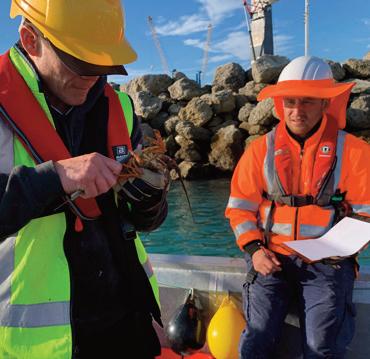
3 minute read
Australasia focus
MARINE HEALTH MONITORING FIRST
New Zealand's Napier Port has launched the first marine cultural health programme (MCHP) of its kind in the country - and possibly unique in the world, writes Dave MacIntyre
Working in partnership with indigenous Māori to protect the local marine environment, the programme provides real-time monitoring of the state of health of the Ahuriri (Napier) marine environment and will lay the foundation for the future restoration and enhancement of this area, which is important to the mana whenua (people of the land) of Te Matau a Māui (Hawke's Bay).
The area contains taonga (places of cultural value), is the home of Pānia Reef (a site of cultural significance as the embodiment of the sea maiden Pānia) and Moremore Maitaitai Reserve. Pānia Reef is also an important site for gathering kaimoana (seafood).
HOLISTIC APPROACH
What began as a community consultation in 2016 when planning for the new 6 Wharf evolved into a cultural impact assessment that recommended cultural monitoring of the Ahuriri marine area.
This led to the creation of a steering committee in 2019 consisting of representatives from 11 different marae (Māori tribal meeting places) and hapū (sub tribes), which has shaped the MCHP.
At the heart of programme is a new Cultural Monitoring Framework (CMF), that balances Western science and a Māori worldview in order to provide a holistic representation of ecological and cultural health of the marine environment.
The framework embodies the important Māori concept of kaitiakitanga or guardianship - an obligation to care for the environment and maintain it for future generations.
The CMF monitors health by using two metrics. Mana Moana represents the health and wellbeing of the Ahuriri marine ecosystem, and Mana Tangata represents the strength of connection of mana whenua to the marine environment.
The health of each metric is measured through a “family tree” of key and sub indicators, and the health of each indicator is determined through qualitative and quantitative data which collectively assess the overall health of the Ahuriri area and its people. This data is available to the public in real-time on a marine cultural monitoring website.
Napier Port's environmental monitoring programme includes dive surveys, buoy data on water clarity, fishing surveys and marine mammal observations. Hawke's Bay Regional Council's coastal monitoring programmes adds inter-tidal reef monitoring, coastal water and recreational water quality, shellfish monitoring and sediment analysis.
COMMUNITY BACKING
The CMF then adds significant other information such as conducting surveys with mana whenua, and field monitoring specific to historically-important marine and food species, such as crayfish, green-lipped mussels and fish. Over 230 qualitative and quantitative pieces of information are given a score during this monitoring.
The MCHP is managed by Te Kaha Hawaikirangi, Napier Port's Pou Tikanga (cultural advisor) and Environmental Advisor. He says designing the programme from scratch has been a big challenge, but working closely with mana whenua, marae and hapū has created a new innovative programme that speaks to the rich cultural traditions of Ahuriri, its people and environment.
“Our Cultural Monitoring Framework is also designed so other mana whenua or indigenous peoples can replicate the framework. It provides a means to measure and input information of importance in a way that provides an overall indicator of health.”
Michel de Vos, Napier Port's General Manager Infrastructure Services, says buy-in from local hapū was achieved by engaging from the beginning of the project and then throughout the process of forming the consent application and ultimately the application and hearing.
“With the cultural marine health monitoring right from the start we supported the idea and proposed it as a condition in our consent application. I think it is fair to say this is a New Zealand if not world's first and we did not really know what the end product might look like, so there was a big leap of faith on all sides," he says.
“I think everybody should be proud of the result."
Construction on 6 Wharf commenced at the start of 2020 and is due to be completed at the end of 2022.
To view the cultural health of the Ahuriri Marine environment in real-time visit www.marineculturalhealth.co.nz
8 The programme








